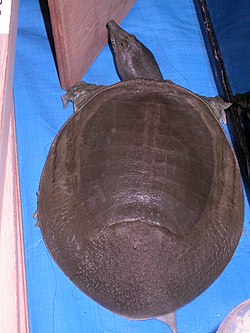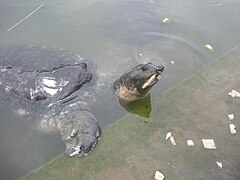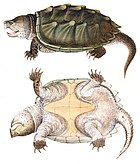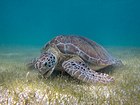鳖
| 鳖科 | |
|---|---|

| |
| 中华鳖(Pelodiscus sinensis) | |
| 科学分类 | |
| 界: | 动物界 Animalia |
| 门: | 脊索动物门 Chordata |
| 纲: | 爬行綱 Reptilia |
| 目: | 龜鱉目 Testudines |
| 亚目: | 曲颈龟亚目 Cryptodira |
| 下目: | 真曲颈龟下目 Eucryptodira |
| 演化支: | 近代曲颈龟类 Polycryptodira |
| 总科: | 鳖总科 Trionychoidea |
| 科: | 鳖科 Trionychidae Fitzinger, 1826 |
| 亚科 | |
| |
鳖(biē,又作鼈)是对鳖科(學名:Trionychidae)的一类软壳龟的统称[註 1],隶属龟鳖目下的曲颈龟亚目,中文俗稱甲鱼、團魚、水鱼、泥龟、王八等。约在1.5亿年前的侏罗纪晚期发源于亚洲,并在6,000万年前的古新世中期扩散至北美洲和非洲等地,多栖息于河流、池沼、稻田等淡水生境。現存2亞科、13属、约30种,其中一些种类是现存体型最大的淡水龟鳖目动物。
鳖科高度适应水下生活,能以腋窝直接吸收水中的氧气,亦可在水中2-3个小时不呼吸。常潜伏在水底的泥沙上,捕食小型水生动物,并会钻进泥沙里冬眠。体呈暗绿色;吻部突出,状似猪鼻,长度和厚度因种类而异;每足仅有三个趾爪,趾间常有蹼,可助其快速游泳[2]。与龟鳖目中称作“龟”的物种相比,鳖的体形较为扁平,背甲由可见的肋板支撑革质软皮组成,而非坚硬并具有纹理的角质盾片,其外缘柔韧无骨板,称作“裙边”。
鳖科因其肉味鲜美且营养价值较高,常被人类作为补品食用,部分种类已濒临灭绝。
下級分类
根據 Walter 等人在2009年發表的論文,鱉科內部的分化關係如下[3](符号 † 表示已灭绝):
| 鱉科 Trionychidae |
| ||||||||||||||||||||||||||||||||||||||||||||||||||||||||||||||||||||||||||||||||||||
本科包括以下属:
- 軟鱉屬 Amyda Geoffroy, 1809
- 滑鱉屬 Apalone Rafinesque, 1832
- Aspideretoides Gardner, Russell & Brinkman, 1995
- Aspidonectes Wagler, 1830
- Atoposemys Hutchison, 2013
- Aulacochelys Lydekker, 1889
- Axestemys Cope, 1872
- Basilochelys Tong, Claude, Naksri, Suteethorn, Buffetaut, Khansubha, Wongko & Yuangdetkla, 2009
- Basilochelys macrobios Tong et al., 2009[5]
- 小头鳖属 Chitra Gray, 1844
- Coelognathus Heude, 1880
- Conchochelys Hay, 1905
- Coptopelta Heude, 1880
- Crassithecachelys Chkhikvadze, 2000
- Cryptopus Duméril & Bibron, 1835
- 盤鱉屬 Cyclanorbis Gray, 1854
- Cycloderma Peters, 1854
- Derrisemys Hutchison, 2009
- 纹鳖属 Dogania Gray, 1844
- Eugenechelys Chkhikvadze, 2000
- Gilmoremys Joyce & Lyson, 2011
- Gobiapalone Danilov, Hirayama, Sukhanov, Suzuki, Watabe & Vitek, 2014
- Gomphopelta Heude, 1880
- Gymnopodus Duméril & Bibron, 1835
- Gymnopus Duméril & Bibron, 1834
- Helopanoplia Hay, 1908
- Hummelichelys Chkhikvadze, 2000
- 哈奇森鳖属 Hutchemys Joyce, Revan, Lyson & Danilov, 2009
- Jimemys Edgar, Brinkman, Ryan & Evans, 2022
- Khunnuchelys Brinkman, Nessov & Peng, 1993
- Kuhnemys Chkhikvadze, 1999
- 緣板鱉屬 Lissemys Smith, 1931
- Murgonemys White, 2001
- Nemegtemys Danilov, Hirayama, Sukhanov, Suzuki, Watabe & Vitek, 2014
- Nilssonia Gray, 1872
- 丽鳖属 Nilssonia Hay, 1904
- Oliveremys Vitek, 2011
- Palaeoamyda Cadena, 2016
- 山瑞鱉屬 Palea Meylan, 1987
- Palea Siebenrock, 1906
- Paleotrionyx Schmidt, 1945
- 黿屬 Pelochelys Gray, 1864
- 中华鳖属 Pelodiscus Fitzinger, 1835
- Perochelys Li, Joyce & Liu, 2015
- Petrochelys Vitek, Danilov, Nakajima & Hirayama, 2017
- Plastomenoides Hutchison, 2009
- 团板鳖属 Plastomenus Cope, 1873
- Psilognathus Heude, 1880
- Rafetoides Karl, 1998
- 斑鱉屬 Rafetus Gray, 1864
- Sinaspideretes Young & Chow, 1953
- Temnognathus Heude, 1880
- Temnotrionyx Hay, 1908
- Tetrathyra Gray, 1865
- Tortisternum Heude, 1880
- 鳖属 Trionyx Saint-Hilaire, 1809
- Ulutrionyx Kordikova, 1994
- Zangerlichelys Chkhikvadze, 2000
分布

鳖主要生活在亚洲、非洲和美洲的淡水湖泊、池塘、水庫、三角湾及流动缓慢的河里。
特征
鳖外形似龟,具有圆而平的骨质背甲。和其他龟鳖目动物不同,鳖的背甲不具角质盾片,仅覆以柔软的革质皮肤。腹板退化,舌腹甲(hyoplastron)与下腹甲(hypoplastron)之间的联体上有明显增厚的部分,称作“胼胝体”。背、腹甲以结缔组织相连,背甲边缘为厚实的结缔组织,称作“裙边”[4]。雌性的尾巴一般不达裙边外缘,雄性大都伸出裙边外。
颈长,垂直内缩,头与颈能缩入体内。两颚被肉质软唇,吻端形成一个吻突。外耳孔不显。四肢粗短稍扁平,为五趾型,趾间有蹼,内侧三个趾有爪[4]。
某些大型鳖类的体长可达1米以上[2],雌性通常比雄性大一倍。
食性
鳖为水生杂食动物,性情较为凶猛,喜食动物性饵料。幼鳖以水生昆虫、蚯蚓、蝌蚪、小虾等为食。成鳖摄食田螺、蛤蜊等軟體動物、鱼、虾以及动物尸体,也食蔬菜、水果、杂粮等植物性饲料。
繁殖
鳖蛋的孵化温度可以影響鳖的性别。以中华鳖为例:试验结果表明,以29 ℃ 为界,低于这个温度,孵化出来的中华鳖趋向于向雌性转化;而温度高于29 ℃ 后,添加了一定化学诱导剂的中华鳖孵化出来,雄性率达77.03 %。[6]
圖冊
-
角鱉
-
幼發拉底鱉
注釋
參考文獻
- ^ 李录. 中国早白垩世鳖类两新种兼论中国中生代化石鳖类[D]. 北京: 中国科学院大学, 2013.
- ^ 2.0 2.1 Softshell turtle. Encyclopædia Britannica Online. Encyclopædia Britannica, Inc. [2020-12-02]. (原始内容存档于2021-04-26).
- ^ Joyce, Walter G.; Revan, Ariel; Lyson, Tyler R.; Danilov, Igor G. Two New Plastomenine Softshell Turtles from the Paleocene of Montana and Wyoming. Bulletin of the Peabody Museum of Natural History. 2009-10, 50 (2). ISSN 0079-032X. doi:10.3374/014.050.0202 (英语).
- ^ 4.0 4.1 4.2 张孟闻, 宗愉, 马积藩. 中国动物志: 爬行纲第一卷[M]. 北京: 科学出版社, 1998.
- ^ Haiyan Tong, Julien Claude, Wilailuck Naksri, Varavudh Suteethorn, Eric Buffetaut, Sasidhorn Khansubha, Kamonrak Wongko and Phisit Yuangdetkla. 2009. Basilochelys macrobios n. gen. and n. sp., A Large Cryptodiran Turtle from the Phu Kradung Formation (latest Jurassic-earliest Cretaceous) of the Khorat Plateau, NE Thailand. In: Buffetaut, E.; Cuny, G.; Le Loeuff, J. & Suteethorn, V. (eds.). Late Palaeozoic and Mesozoic Ecosystems in SE Asia. Geological Society, London, Special Publications. 315: 229-243. DOI: 10.1144/SP315.12
- ^ 甲鱼说了:我的性别市场说了算. 杭州日报. [2006-12-14]. (原始内容存档于2020-04-04).
- 鳖科 (页面存档备份,存于互联网档案馆)(所有种)-爬行动物数据库 (页面存档备份,存于互联网档案馆)
- Parade of the Animal Kingdom. Hegner, Robert. 1935. the Macmillan Company.
延伸阅读
[在维基数据编辑]
| |||||||||||||||||||||||||||||||||||||||||||||||||||||||||||||||||||||||||||||||||||||||||||||||||||||||||||||||||||||||||||||||||||||||||||||||||||||||||||||||||||||||||||||||||||||||||||||||||||||||||||||||||||||||||||||||||||||||||||||||||||||||||||||||||||||||||||||||||||||||||||||||||||||||||||||||||||||||||||||||||||||||||||||||||||||||||||||||||||||||||||||||||||||||||||||||||||||||||||||||||||||||||||||||||||||||||||||||||||||||||||||||||||||||||||||||||||||||||||||||||||||||||||||||||||||||||||||||
Text is available under the CC BY-SA 4.0 license; additional terms may apply.
Images, videos and audio are available under their respective licenses.





















